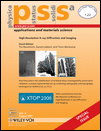Synchrotron-radiation computed laminography for high-resolution three-dimensional imaging of flat devices
Abstract
Synchrotron-radiation computed laminography (SRCL) is developed as a method for high-resolution three-dimensional (3D) imaging of regions of interest (ROIs) in all kinds of laterally extended devices. One of the application targets is the 3D X-ray inspection of microsystems. In comparison to computed tomography (CT), the method is based on the inclination of the tomographic axis with respect to the incident X-ray beam by a defined angle. With the microsystem aligned roughly perpendicular to the rotation axis, the integral X-ray transmission on the two-dimensional (2D) detector does not change exceedingly during the scan. In consequence, the integrity of laterally extended devices can be preserved, what distinguishes SRCL from CT where ROIs have to be destructively extracted (e.g. by cutting out a sample) before being imaged. The potential of the method for three-dimensional imaging of microsystem devices will be demonstrated by examples of flip-chip bonded and wire-bonded devices. (© 2007 WILEY-VCH Verlag GmbH & Co. KGaA, Weinheim)




